Ulverston, Lancashire
Up to 1834
In 1753, Neville Hall was purchased for the sum of £163-3s. for use as a parish poorhouse for Ulverston. (The building, built by Edmund Neville, was the Neville family home until 1569 when the estate was confiscated by the Crown.) In 1770, its operation was contracted out to John Fell for an annual payment of £140. In 1845, after the erection of the new Ulverston Union workhouse, the Hall was sold for £545 to Mr Woodburn Postlethwaite. The net proceeds (£381-6s-8d. after defraying costs and expenses) were invested in annuities for the benefit of the poor of the parish, generating the sum of £11-1s-2d per annum to be distributed by the Churchwardens and overseers at Christmas each year.
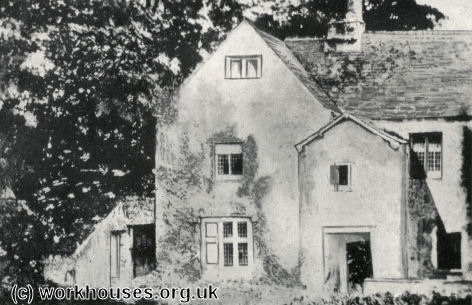
Neville Hall.
© Peter Higginbotham.
Neville Hall was partially demolished in 1881 to make way for a house for the Superintendent of Police, the remainder surviving until 1909. All that now remains are the name Neville Street and the coat of arms over Neville House.
Other parish workhouses in the area included one at Billincoat in the parish of Dalton which according to the first page of its account book was 'Opened June 11th 1735 By Mr. Hinde To Serve ye poore & Blinde'. Mr Hinde's quarterly 'sallary for managing the poor-house' was £1-5s. In 1775, rhe workhouse could house up to 20 inmates. In 1826, the Dalton workhouse moved to a new site at Goose Green, some of whose buildings still survive.
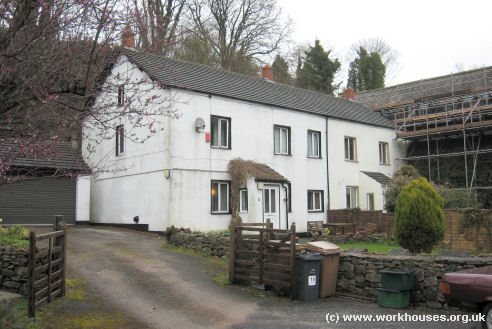
Dalton former workhouse, 2010.
© Peter Higginbotham.
Because an illegitimate child's settlement (and any future poor relief) was determined by the parish of its birth, it was not uncommon for parish authorities to try and persuade unmarried mothers-to-be not to give birth within their boundaries. In 1744, the Dalton workhouse was the scene of an incident involving a young woman named Mary Simpson who died after being forcibly removed because she came from Cumberland. Below is a deposition by the midwife who attended her:
To wit. The Information of Eliz: Askew of Lady Hall, midwife, taken upon Oath before me one of his Majestie's Justices of the Peace in and for the sd. County this 25 day of May 1744.
Who saith that on the Monday morning before about two o' clock she was called to assist Mary Simpson, who was then in Labour of a Bastard Child at the House of Joseph Hargreaves at Lady Hall aforesd. that the said Simpson declared she had Labour pains upon her the day before and had been very ill in the Workhouse at Dalton about a fortnight before and expected to lie there and that she was in Greatest Concern and fear when she saw the Inhabitants of Dalton come with a Horse and Pillion so as to fetch her away and fell into a violent sweat thereupon and that the Inhabitants of the parish of Dalton used threatening words to induce her to come from the sd. Workhouse that James Hall who rode before her rode fast and that she was much jumbled and hurt by the riding, and this Informant believes that considering the Circumstances she found the said Simpson in that she was much hurt by the riding and brought into a condition thereby which prevented her Delivery, which she could fully explain to a Midwife or Surgeon and that she Died in Labour without being delivered, on the Tuesday morning following.
Sworn before me
R. G. Sawrey
A parliamentary report in 1777 recorded parish workhouses in operation at Colton (or Coulton) for up to 18 inmates. A new workhouse was erected at Backbarrow in 1823 at a cost of £250.
In September, 1817, the Ulverston Overseers were advertising in the Lancaster Gazettefor a Master and matron for the workhouse where the inmates' labour apparently included weaving.
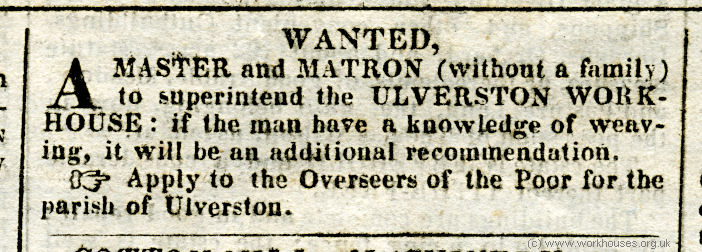
Advertisement for Master and Matron, 1817.
After 1834
Ulverston Poor Law Union was formed on 26th August 1836. Its operation was overseen by an elected Board of Guardians, 36 in number, representing its 27 constituent parishes as listed below (figures in brackets indicate numbers of Guardians if more than one):
County of Lancaster:
Aldingham (2), Lower Allithwaite, Upper Allithwaite, East Broughton, West Broughton (2), Blawith, Cartmel Fell, Church Coniston, Claife, Colton (2), Dalton (2), Dunnerdale-with-Seathwaite, Egton-wth-Newland, Hawkshead and Monk Coniston-with-Skelwith (2), Upper Holker, Lower Holker, Kirkby Ireleth, Lowick, Mansriggs, Osmotherly, Pennington, Satterthwaite, Suberthwaite, Torver, Staveley, Ulverston (4), Urswick.
Later Additions: Angerton (from 1858), Barrow-in-Furness (from 1851), Coniston (from 1894), Grange (from 1894), Haverthwaite(from 1927), Hawkshead (from 1894), Skelwith (from 1894).
The population falling within the Union at the 1831 census had been 22,563 - ranging from Mansriggs (population 69) to Ulverston itself (4,876). The average annual poor-rate expenditure for the period 1834-36 had been £10,089.
At the start of 1837, advertisements were placed for land suitable for the building of a new workhouse.
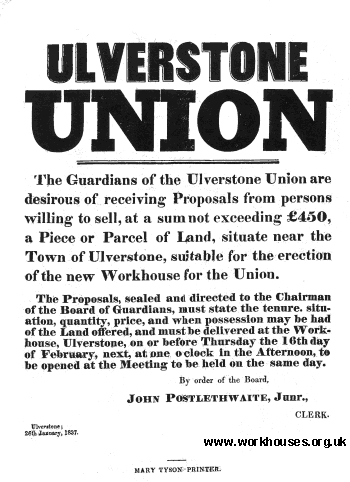
Advertisement for land dated 16th January, 1837.
The new Ulverston Union workhouse was built at the north-west of the town on the west side of Stanley Street, off the Gill, at a cost of £5,800. Its layout was based on the standard cruciform design by Sampson Kempthorne. The architect of the Ulverston is believed to be George Webster of Kendal, who also designed the TSB building in Market Street, Ulverston, although the design has also been attributed to Edward William Trendell. The workhouse layout is shown on the 1852 map below:
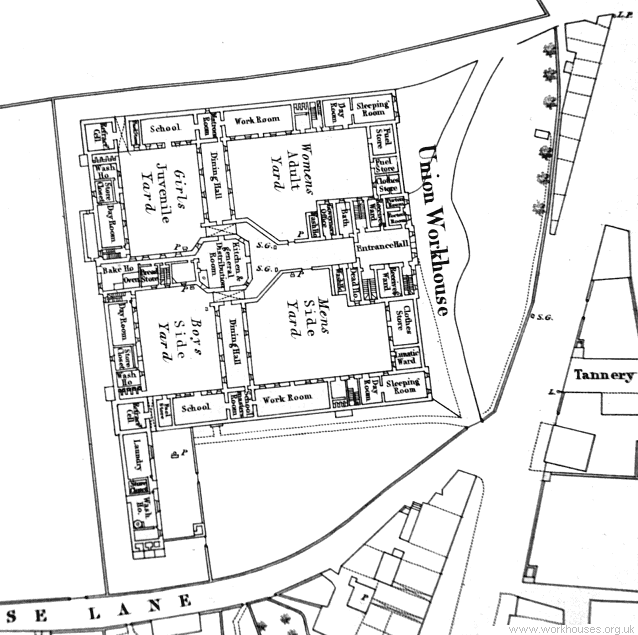
Ulverston workhouse site, 1852.
A small infirmary appears to have been added in around 1868, although this was later demolished, probably to make way for the separate children's accommodation at the west of the site. By 1887, after a recent enlargement, the workhouse could accommodate 282 inmates.
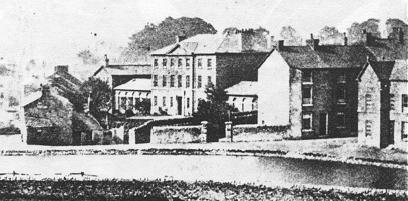
An 1880s view of the workhouse across Mill Pond.
The later site layout can be seen on the 1911 map below.
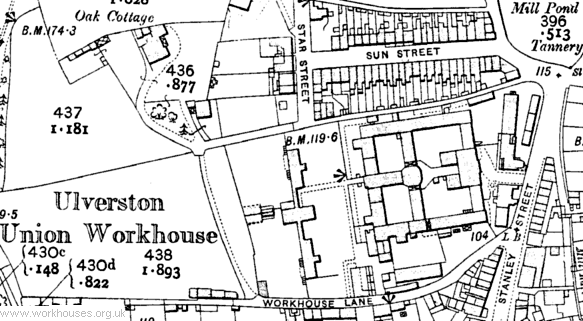
Ulverston workhouse site, 1911.
Barrow-in-Furness became a separate union in 1876, with its own workhouse being built in 1878-9.
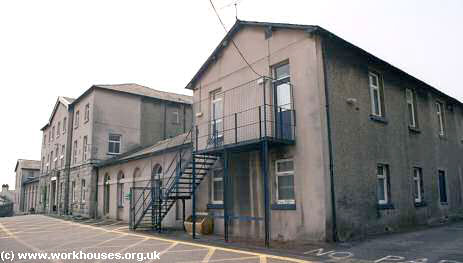
Ulverston main building from the north, 2001.
© Peter Higginbotham.
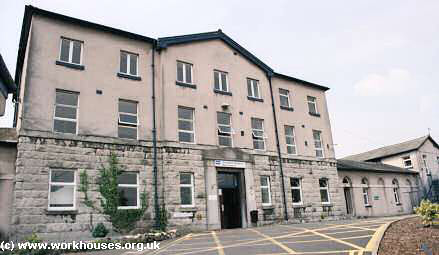
Ulverston main building entrance from the east, 2001.
© Peter Higginbotham.
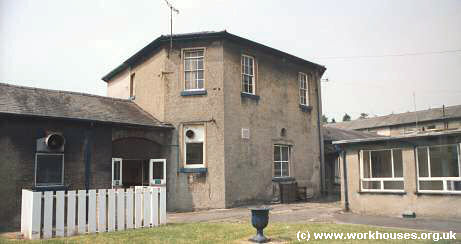
Ulverston central hub from the south-east, 2001.
© Peter Higginbotham.
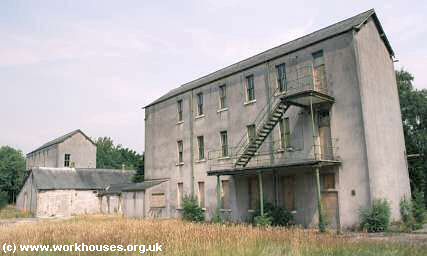
Ulverston children's quarters from south-west, 2001.
© Peter Higginbotham.
A porter's lodge and casual wards were added at the east of the workhouse. The block at the northern side contained a row of sleeping and stone-breaking cells as can be see on the early 1960s aerial view below which is taken from the west of the site.
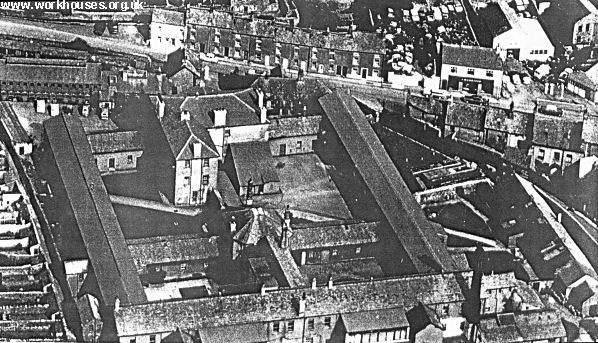
Ulverston workhouse aerial view from the west, c.1963.
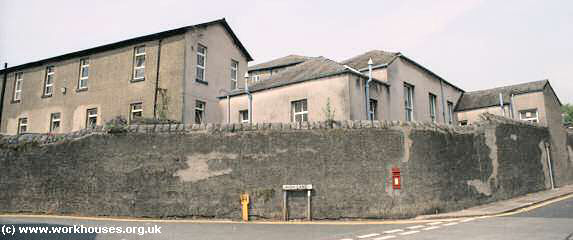
Ulverston site from the south-east with casual wards and porter's lodge at right, 2001.
© Peter Higginbotham.
Ulverston's establishment later became known as Stanley Hospital, then after the closure and demolition of the Ulverston Hospital on Newton Street in 1971, it adopted the name Ulverston Hospital.
The old children's blocks were demolished in 2002 to make way for a new unit for the elderly mentally ill. The rest of the buildings were demolished in summer 2003 and replaced with a new primary care resource centre.
Staff
Inmates
Records
Note: many repositories impose a closure period of up to 100 years for records identifying individuals. Before travelling a long distance, always check that the records you want to consult will be available.
- Barrow Archive and Local Studies Centre, 140 Duke Street, Barrow-in-Furness, Cumbria LA14 1XW. Holdings include: Births register (1866-1948); Deaths register (1866-1916); Punishments register (1874-1923); etc.
Bibliography
- Walton, James E (1984) A History of Dalton-in-Furness (Phillimore)
 Whitehead, June (2006) Lost Children; Ulverston Workhouse in the 19th Century (Handstand Press) - copies available at £4.99 from the Tinner's Rabbit bookshop, Ulverston or direct from the author - email june.whitehead@btinternet.com.
Whitehead, June (2006) Lost Children; Ulverston Workhouse in the 19th Century (Handstand Press) - copies available at £4.99 from the Tinner's Rabbit bookshop, Ulverston or direct from the author - email june.whitehead@btinternet.com.
Links
Acknowledgements
- Thanks to Elizabeth Ellis for help in compiling this page.
Unless otherwise indicated, this page () is copyright Peter Higginbotham. Contents may not be reproduced without permission.


